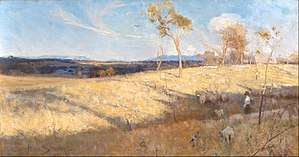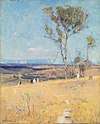Golden Summer, Eaglemont
| Golden Summer, Eaglemont | |
|---|---|
 | |
| Artist | Arthur Streeton |
| Year | 1889 |
| Medium | Oil on canvas |
| Dimensions | 81.3 cm × 152.6 cm (32.01 in × 60.08 in) |
| Location | National Gallery of Australia, Canberra |


Golden Summer, Eaglemont is an 1889 painting by Australian artist Arthur Streeton. Painted during a summer drought when Streeton was twenty-one years old, it is an idyllic depiction of sunlit, undulating plains in rural Heidelberg on Melbourne's outskirts. Naturalistic yet poetic, and a conscious effort by Streeton to create his most epic work yet, it is a prime example of the artist's distinctive, high-keyed blue and gold palette, what he considered "nature's scheme of colour in Australia". It is one of his most famous works and is considered a masterpiece of Australian Impressionism.
Background
Streeton painted it en plein air in January 1889 at an artists' camp he established the previous year at Mount Eagle (now Eaglemont), near Heidelberg, on the outskirts of Melbourne. There, Streeton, Charles Conder, Tom Roberts and occasionally other artists occupied an old weatherboard house. Streeton described the location in a letter to Roberts, calling it "our hill of gold":
I sit here in the upper circle surrounded by copper and gold, and smile with joy under my fly net as all the light, glory and quivering brightness passes slowly and freely before my eyes. Nothing happier than this. I shout and laugh at my immense wealth, all free and without responsibility. Who could steal this from me? No one.
Years later, Streeton recalled painting Golden Summer as he, Conder, and fellow plein air painter John Ford Paterson shared cheese and a bottle of claret.[1]
Exhibition and reception
The so-called "impressionist school" at Heidelberg has done some good after all.
Table Talk reported in 1889 that Golden Summer, Eaglemont "abundantly testifies to [Streeton's] perfect sense of colour ... He paints summer effects as if he loved the country."[3] When the painting appeared at the Victorian Artists Society's 1889 winter show, the critic for The Argus, while opposed to what he called "the impressionist fad", said Golden Summer "is the best example of this class of work in the exhibition."[4]
Conder took Golden Summer, Eaglemont to London in April 1890, where, the following year as Golden Summer, Australia, it became the first painting by an Australian-born artist to be exhibited at the Royal Academy. In 1892, it appeared at the Paris Salon, and won an award. One critic noted the popularity of Golden Summer with "the crowds that throng the Salon", saying that it was "simply impossible" to pass by the painting "as it is utterly different from any other picture in the vast collection".[5] Likewise, Australian artist John Longstaff, then based in Paris, said the painting "created quite a sensation and stood out in oneness and quality all through everything else on the walls."[3]
Provenance
Scottish shipbuilder Charles Mitchell purchased Golden Summer, Eaglemont on the opening day of the 1892 Paris Salon. It remained part of his estate until Streeton re-acquired the painting from Mitchell's widow in 1919.
Ahead of its public auction in Australia in 1924, Lionel Lindsay extolled the work in the hope that it would enter a public gallery:[6]
This tranquil landscape, so simply yet so exquisitely fashioned, possesses for Australians a sentiment no other people may equally enjoy. It is the first great Australian landscape, untrammeled by picture making formula, to come from the hand of the native born. It is, therefore, historically the most important landscape in Australia.
A private collector acquired it for 1,000 guineas, then a record for a painting by an Australian artist. Streeton used the money to commission an architect to design and build 'Longacres', a new house and studio Olinda, outside Melbourne.[7] Golden Summer broke the same sales record in 1995 when the National Gallery of Australia purchased it for $3.5 million.[8]
References
- ↑ "Australian Art: Mr Streeton's Return: Memories of Heidelberg" (3 February 1922), The Argus. Retrieved 2 August 2018.
- ↑ "Melbourne". The Colac Herald. 29 May 1891. p. 3. Retrieved 18 March 2016.
- 1 2 Clark, Jane (1985). "Heidelberg Summers". In Ryan, Judith. Golden Summers: Heidelberg and Beyond. International Cultural Corporation of Australia. pp. 104–105. ISBN 0-642-09855-7.
- ↑ "The Winter Exhibition of the Victorian Artists' Society". The Argus. 4 May 1889. p. 12. Retrieved 18 March 2016.
- ↑ "The Australian Artists in Paris" (17 August 1892), The Argus. Retrieved 24 February 2017.
- ↑ Lindsay, Lionel (28 November 1923). "Golden Summer: Streeton's Masterpiece", Evening News. Retrieved 11 August 2014.
- ↑ James, Rodney (2 November 2017). "Arthur Streeton", Menzies Art Brands. Retrieved 6 August 2018.
- ↑ Maher, Louise (4 July 2017). "Arthur Streeton's impressionist masterpiece Golden Summer, Eaglemont back on show at NGA". ABC News. Retrieved 1 August 2018.
External links
Golden Summer, Eaglemont at the National Gallery of Australia
